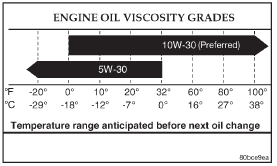Jeep Cherokee (XJ): Engine oil service
WARNING: NEW OR USED ENGINE OIL CAN BE IRRITATING TO THE SKIN. AVOID PROLONGED OR REPEATED SKIN CONTACT WITH ENGINE OIL.
CONTAMINANTS IN USED ENGINE OIL, CAUSED BY INTERNAL COMBUSTION, CAN BE HAZARDOUS TO YOUR HEALTH. THOROUGHLY WASH EXPOSED SKIN WITH SOAP AND WATER. DO NOT WASH SKIN WITH GASOLINE, DIESEL FUEL, THINNER, OR SOLVENTS, HEALTH PROBLEMS CAN RESULT. DO NOT POLLUTE, DISPOSE OF USED ENGINE OIL PROPERLY.
ENGINE OIL SPECIFICATION
CAUTION: Do not use non-detergent or straight mineral oil when adding or changing crankcase lubricant. Engine failure can result.
API SERVICE GRADE CERTIFIED
In gasoline engines. use an engine oil that is API Service Grade Certified (Fig. 37).
Standard engine oil identification notations have been adopted to aid in the proper selection of engine oil. The identifying notations are located on the label of engine oil plastic bottles and the top of engine oil cans (Fig. 37).
SAE VISCOSITY
An SAE viscosity grade is used to specify the viscosity of engine oil. SAE 10W-30 specifies a multiple viscosity engine oil.
When choosing an engine oil, consider the range of temperatures the vehicle will be operated in before the next oil change. Select an engine oil that is best suited to your area's particular ambient temperature range and variation (Fig. 38).

Fig. 37 Engine Oil Container Standard Notations

Fig. 38 Temperature/Engine Oil Viscosity
ENERGY CONSERVING OIL
An Energy Conserving type oil is recommended for gasoline engines. The designation of ENERGY CONSERVING is located on the label of an engine oil container.
CRANKCASE OIL LEVEL INSPECTION
CAUTION: Do not overfill crankcase with engine oil, oil foaming and oil pressure loss can result.
The engine oil level indicator (Dipstick) is located at the right rear of the 2.5L engine. Inspect engine oil level approximately every 800 kilometers (500 miles). Unless the engine has exhibited loss of oil pressure, run the engine for about five minutes before checking oil level. Checking engine oil level on a cold engine is not accurate.
To ensure proper lubrication of an engine, the engine oil must be maintained at an acceptable level.
The acceptable levels are indicated between the ADD and SAFE marks on the engine oil dipstick (Fig. 39).
(1) Position vehicle on level surface.
(2) With engine OFF, allow approximately ten minutes for oil to settle to bottom of crankcase, remove engine oil dipstick.
(3) Wipe dipstick clean.
(4) Install dipstick and verify it is seated in the tube.
(5) Remove dipstick, with handle held above the tip, note oil level reading (Fig. 39).
(6) Add oil only if level is below the ADD mark on dipstick.

Fig. 39 Engine Oil Dipstick-2.5L Engine
1 - DIPSTICK
2 - SAFE
3 - ADD
ENGINE OIL CHANGE
Change engine oil at mileage and time intervals described in Maintenance Schedules.
Run engine until achieving normal operating temperature.
(1) Position the vehicle on a level surface and turn engine off.
(2) Hoist and support vehicle on safety stands.
(3) Remove oil fill cap.
(4) Place a suitable drain pan under crankcase drain.
(5) Remove drain plug from crankcase and allow oil to drain into pan. Inspect drain plug threads for stretching or other damage. Replace drain plug if damaged.
(6) Install drain plug in crankcase.
(7) Lower vehicle and fill crankcase with specified type and amount of engine oil described in this section.
(8) Install oil fill cap.
(9) Start engine and inspect for leaks.
(10) Stop engine and inspect oil level.
ENGINE OIL FILTER CHANGE
FILTER SPECIFICATION
CAUTION: Do not use oil filter with metric threads.
The proper oil filter has SAE type 3/4 X 16 threads.
An oil filter with metric threads can result in oil leaks and engine failure.
All Jeep engines are equipped with a high quality full-flow, throw-away type oil filter. Chrysler Corporation recommends a Mopar or equivalent oil filter be used.
OIL FILTER REMOVAL
(1) Position a drain pan under the oil filter.
(2) Using a suitable oil filter wrench loosen filter.
(3) Rotate the oil filter counterclockwise to remove it from the cylinder block oil filter boss (Fig. 40).

Fig. 40 Oil Filter-2.5L Engine
1 - OIL FILTER
(4) When filter separates from adapter nipple, tip gasket end upward to minimize oil spill. Remove filter from vehicle.
(5) With a wiping cloth, clean the gasket sealing surface (Fig. 41) of oil and grime.
OIL FILTER INSTALLATION
(1) Lightly lubricate oil filter gasket with engine oil or chassis grease.
(2) Thread filter onto adapter nipple. When gasket makes contact with sealing surface, (Fig. 41) hand tighten filter one full turn, do not over tighten.
(3) Add oil, verify crankcase oil level and start engine. Inspect for oil leaks.

Fig. 41 Oil Filter Sealing Surface-Typical
1 - SEALING SURFACE
2 - RUBBER GASKET
3 - OIL FILTER
USED ENGINE OIL DISPOSAL
Care should be exercised when disposing used engine oil after it has been drained from a vehicle engine. Refer to the WARNING at beginning of this section.
 Repair damaged or worn threads. Service engine assembly (short block). Hydrostatic lock
Repair damaged or worn threads. Service engine assembly (short block). Hydrostatic lock
Other materials:
Governor and park gear. Valve body. Transmission
Governor and park gear
DISASSEMBLY
(1) Remove governor body from transmission.
(2) Clean and inspect governor filter (Fig. 89).
(3) Remove snap ring and washer that secure governor
weight assembly in body (Fig. 90).
(4) Remove governor weight assembly from governor
body bore.
(5) Slid ...

